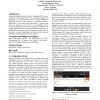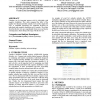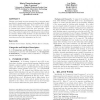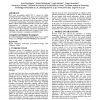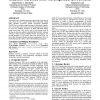ASSETS
2015
ACM
8 years 9 months ago
2015
ACM
People with disabilities rely on assistive technology (AT) software to interact with their mobile device. The overall functionality of AT depends on a set of requirements that are...
ASSETS
2015
ACM
8 years 9 months ago
2015
ACM
People who are blind or visually impaired face difficulties using a growing array of everyday appliances because they are equipped with inaccessible electronic displays. We report...
ASSETS
2015
ACM
8 years 9 months ago
2015
ACM
In this work, we present a platform designed for children with Autism Spectrum Disorder to develop language and generalization skills, in response to the lack of applications tail...
ASSETS
2015
ACM
8 years 9 months ago
2015
ACM
Calendars can be important memory aids for individuals with cognitive disabilities. This study compared the effect of the popular two-dimensional table calendar view and the simpl...
ASSETS
2015
ACM
8 years 9 months ago
2015
ACM
Playing error-based exercises presented in a computer game was found to significantly improve the spelling skills of chil dren with dyslexia in Spanish. Since there are no simi...
ASSETS
2015
ACM
2015
ACM
Faster Text-to-Speeches: Enhancing Blind People's Information Scanning with Faster Concurrent Speech
8 years 9 months ago
Blind people rely mostly on the auditory feedback of screen readers to consume digital information. Still, how fast can information be processed remains a major problem. The use o...
ASSETS
2015
ACM
8 years 9 months ago
2015
ACM
Recent contributions proposed sonification techniques to al low people with visual impairment or blindness to extract information from images on touchscreen devices. In this co...
ASSETS
2015
ACM
8 years 9 months ago
2015
ACM
Most work investigating mobile HCI is carried out within controlled laboratory settings; these spaces are not representative of the real-world environments for which the technolog...
ASSETS
2015
ACM
8 years 9 months ago
2015
ACM
Assessing a user’s situation awareness can provide a great way to learn about the user’s mental model when performing related tasks. Situation Awareness Global Assessment Tech...
ASSETS
2015
ACM
8 years 9 months ago
2015
ACM
Transcription makes speech accessible to deaf and hard of hearing people. This conversion of speech to text is still done manually by humans, despite high cost, because the qualit...
